Curious Case of Coos County - Voter Rolls

Overview
Dr. Douglas G. Frank is a World renown computer expert (see bio below) with over four decades of experience. For the last four years has been analyzing election data around the country.
He visited Coos County in the first week of July in 2024 and gave two presentations. The first presentation was a two plus hour event in Bandon in front of a full house where he explained his background, what data he was looking at (SOS voter rolls), and what curious trends he found in that data. He specifically focused on Coos County voter roll trends and how they mysteriously matched the exact same trends for every county in Oregon.
He also was invited to give a ten minute presentation at the Coos County Board of Commissioners meeting the following day. This article summarizes that presentation.
The point of the presentation was to show that there are certain trends in the statewide population growth and voter roll growth that do not move in synchronization. It also shows that there are trends in ALL the counties voter rolls that move in lock step. If the rolls were maintained only by the county there would be fluctuations as the individual Clerks or Election Officials made changes.
The graphics in this article were part of both presentations and show that the data is not moving in a manner which is statistically possible. All of this data was downloaded from the Oregon Secretary of State website, or the County website.
Election History

The first graph shows the population of the whole state, the people that are registered and voter turn out. As you can see the graph of population rises at a regular rate. The saw tooth effect in the graph of voters is to be expected as less people vote in primaries than in the general elections. What is unexpected is that after 2014 the registered voters surge dramatically, increasing to almost 100% of the available voting age population.
It is clear from this data the effect of certain policies that the state of Oregon has implemented. There is a correlation between this surge and the implementation of automatic registrations by the DMV.
Registration Surge

The second graph shows that the registered votes surged by more than 640,000 people than were justified by population growth. The blue line shows the population trend and the black line shows registered voters. The area in red shows the difference between the population trend and registration trend.
There is nothing wrong with this growth as long as everybody is honest. Having dirty voter rolls is not a problem if everyone is honest.
The problem is that statistically, on average, 25% to 30% of the people in the voter rolls do not belong there. When a door to door canvas of suspect voters was done in Coos County that percentage was proven to be true (see Phantom Voters section, below).
Election History for Coos County
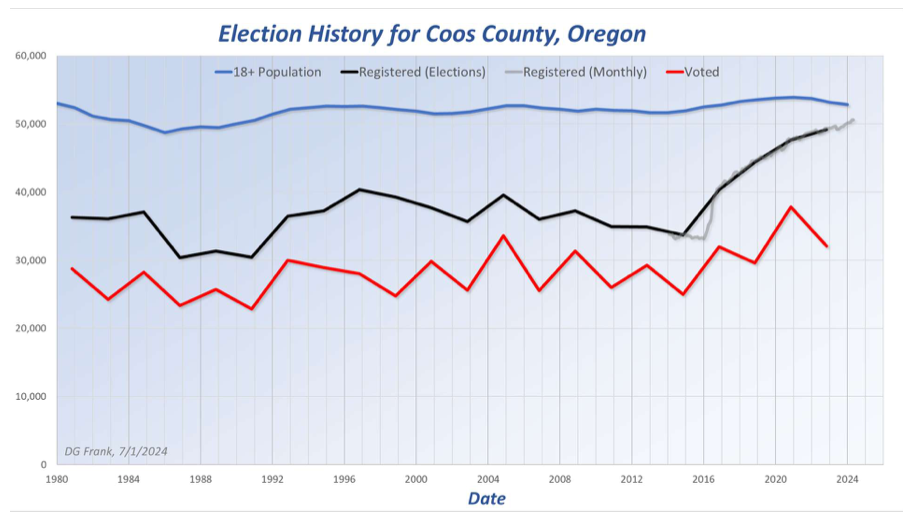
This graph shows the exact same trends as the statewide graph but for Coos County. Notice how the trends and curves match the previous graph. If it was only the County making changes wouldn't you think there would be some deviation?
All Counties Follow The Same Patterns

This graph shows all thirty six Counties in Oregon and how their registration numbers changed from 1980 through 2022. Before 2014 most of the Counties have similar changes, but they don't all change in lock step. After 2014 every single County changes in the same manner and they are all converging on 100% of the voting age population. That is statistically improbable.
Registered Voters, County Breakdown
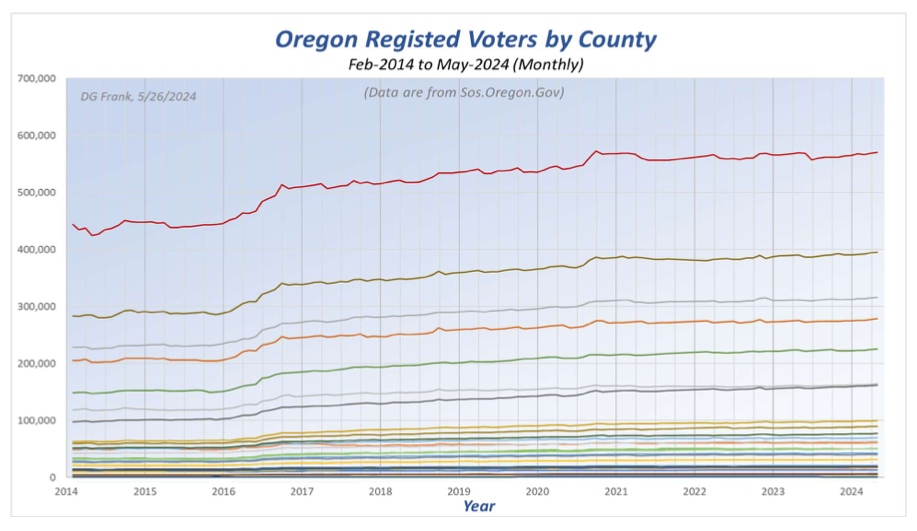
This graph shows the registered voters broken down by County for the February 2014 to May 2024 time frame. Notice how every County marches in lock step. If the Counties were updating their records individually these lines would be much different.

This is the same graph as above, but normalized to percentage of voting age population. Notice how all the Counties (except Wheeler) converge to a point on the right hand side, approaching 100% registration. Once again, this is not natural.
Oregon General Election Turnout
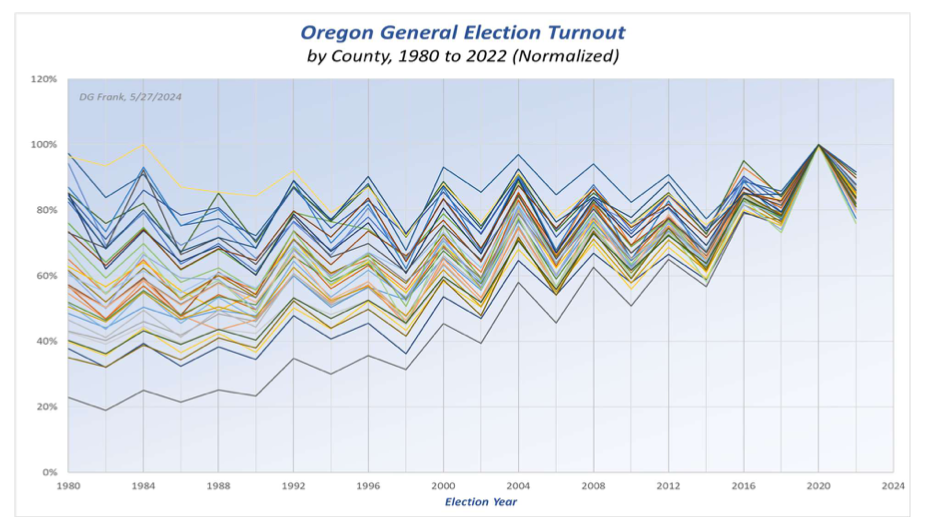
This graph shows the general election turnout for all Oregon Counties from 1980 through 2022, normalized to percentage of turnout. Until 2014 most of the Counties are moving in similar directions, but they have some overlaps as well. This is to be expected with normal, human driven, data. You don't get unity of movement for this kind of data unless they are all being controlled from one source. Plus, it is extremely curious that all lines converge at 2020.
Breaking Down the 2020 Election By Age
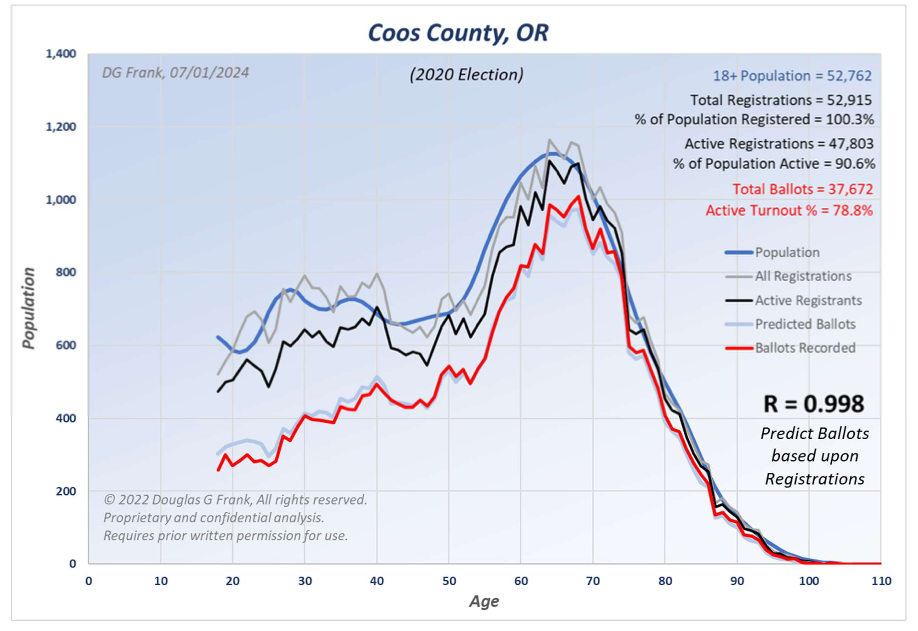
This graph is a breakdown of the 2020 General Election by age for Coos County. Notice in the upper right hand corner that the percentage of population registered is over 100%. This could be explained by the fact that Oregon will allow someone to register when they are 16, but they will not get a ballot until after their 18th birthday.
The light blue line (predicted ballots) that is mostly obscured by the red line (ballots recorded) indicates there is an algorithm in place that can predict with some certainty what the outcome will be. The R number in the lower right hand corner is .998. In statistics, r value correlation means correlation coefficient, which is the statistical measure of the strength of a linear relationship between two variables.
The simple explanation is that the closer you get to the number one, the more accurate the prediction. If r is zero there is no relationship between the ballots returned and the predicted ballots. If it is .30 then it is a weak relationship, .50 is moderate, .70 is strong and 1.0 is exact.
This prediction curve was based on crunching the numbers for numerous elections and calculating a formula. If there was not an algorithm in place the R value for every County would be dramatically different than the formula. This was done for every County in Oregon and the R value was similarly high for all of them, but the prediction for Coos was .998, or almost exact.
Another curious piece of information is that if you look at the graph for all the people over the age of seventy, it looks like they ALL voted. There is almost no difference between active registrants and ballots recorded.
Voter Churn
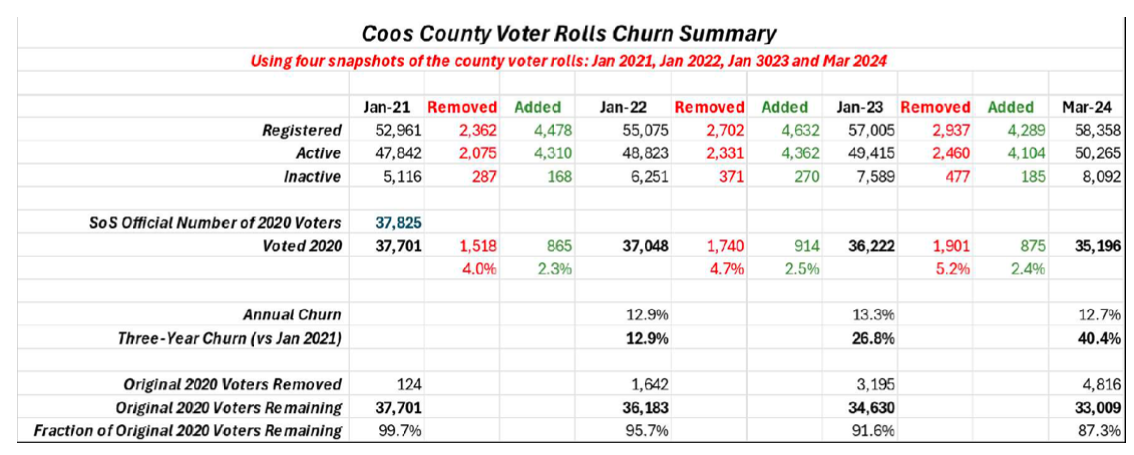
The last item to consider is voter churn. Voter churn in this context simply means the number of voters removed from the rolls and the number of voters added to the rolls that were different.
The voter rolls for January 2021, January 2022, January 2023 and March 2024 were compared. If a name that was one one list was not in the next, it was considered removed. If a name that was in one list was not in the previous list, it was considered added.
In the case of January 2021 there were 2,362 people removed, and 4,478 people added. That makes a churn of 6,840, or 12.9% of the registered voters for 2021. The curious thing about this is that if you look at the churn rate every year is almost the same amount, 12.9% plus or minus .2%.
Another oddity is that the cumulative churn for the four years shown is 40.4%. This means that forty percent of the voter registrations changed in just three years. I find it hard to believe that roughly 21,400 registrations were added or removed locally in just three years. I just don't think Coos County has that many people moving in and out.
What Does This Mean?
The system is literally littering the mailboxes across the County with ballots. If everyone was honest this would not be a problem, but dishonest actors could harvest these ballots and change the outcome of the election. If it were just a few percentage points, it might not make a difference, but this is in excess of 25%, closer to 30%, statewide.
You might be thinking, well that is statewide. We trust our people here in Coos County and we know they are doing their best to keep the rolls clean. This just means that you are not considering the true picture, which is that the STATE is controlling the vast portion of the voter rolls.
The County officials will add and subtract voters based on local registrations and information gleaned about people passing away or moving away, but all of that data is sent to the state. The DMV, ERIC, and other agency updates are done at the state level outside of the county's realm. If the voter rolls were being heavily manipulated out of their view, they would not know.
Phantom Voters
In 2022 Dr. Frank gave us a countywide list of suspected phantom voters and we organized teams of people to do canvassing. Phantom voters are people that might not reside at the given address. They got on the suspect list because numerous individual voters, with different last names, all resided at a single address. It could be possible that this was a natural occurrence in the case of nursing homes or the like. In some cases though the addresses showed up as small single family residences. The only way to find out the phantoms was to canvass those locations and ask.
The results showed that a majority of the phantoms were just that. The residents of the addresses we canvassed had not heard of, or known who, those other voters registered at their address were. Yet, somehow, those phantoms turned in ballots.
The problem with that is that for every phantom voter that turned in a ballot it invalidates YOUR vote. You might have spent a lot of time evaluating the issues, researching the candidates, and perhaps sending money to your candidate of choice. You made an informed decision about how you were going to cast your ballot.
All of that is gone. Your time was wasted and your ballot was invalidated. This is true voter suppression.
What Can We Do?
Simply put, this can be solved by taking back control of the voter rolls at the county level. If every addition and subtraction on the voter rolls is done by someone local we trust, and can hold accountable, then confidence in the elections can be restored.
end of article
Bio
Douglas G Frank is a world-renowned physicist with sixty peer-reviewed scientific publications, including cover and feature articles in the world’s leading scientific journals and Nobel Prize nominee in chemistry. His Ph.D. is in surface-electroanalytical chemistry, which combines chemistry, physics, electronics, advanced computing and mathematics for the manipulation and investigation of molecules on surfaces.
He left university academics in 1996. He has since done extensive consulting, inventing, and technical manufacturing, including electron microscopes, laser scanners, and automated precision manufacturing and quality control devices.
Since December of 2020, Dr. Frank has been working incessantly for election reform with grassroots teams in over forty-eight states, earning the title of “The Johnny Appleseed of Election Integrity.” He’s met in person with dozens of Secretaries of State, Attorneys General, legislators, and hundreds of local election officials.
He has testified formally in several legal and legislative proceedings. Dr. Frank was featured in two of Mike Lindell’s 2021 documentaries (“Scientific Proof” and “Absolute Interference”) because he discovered several of the algorithms being employed to manipulate our elections.